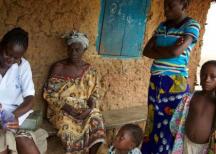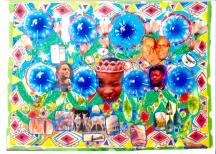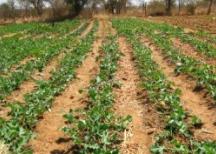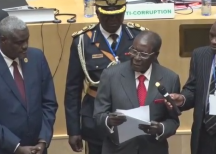The journey just got tougher for civil society activists who have been spearheading efforts to ensure that Southern African Development Community (SADC) governments are legally bound to achieve gender equality, writes Pamela Mhlanga
The SADC Protocol on Gender and Development, due to have been adopted by Heads of State at their meeting in Lusaka, Zambia, in August, has been deferred until the next annual summit to be held in South Africa in mid-2008. The latest draft of the Protocol has had huge chunks removed and concrete commitments softened.
Rising to the challenge, during 16 Days of Activism these activists will be picking up the pace in a campaign to see that a draft Protocol on Gender and Development has the needed commitment and detail necessary to make it a meaningful document in promoting true equality.
SADC is arguably one of the few regions that have done some groundbreaking policy work to institutionalise gender equality. Aside from adoption of a Declaration on Gender and Development in 1997 and an Addendum to address violence against women and children in 1998, all 14 SADC states have ratified the Convention on the Elimination of all forms of Discrimination against Women (CEDAW).
This positive gender equality policy scenario in SADC should lay the basis for a smooth transition from having non-binding SADC instruments to achieve gender equality, such as the 1997 Declaration, to a legally binding one, right? Wrong, as the most recent SADC Heads of State Summit demonstrated.
The baby was almost thrown out with the bath water, when the draft Protocol failed to be adopted, despite having been approved by SADC Gender Ministers, as well as Justice Ministers, the latter having reviewed it in an extraordinary meeting just weeks prior to the August Summit.
The essence of the proposed SADC Gender Protocol is to consolidate all the various commitments made by SADC governments to achieve gender equality and women’s empowerment, in an “omnibus” document. This document will legally bind member states, and provide a framework with time bound targets, for assessing progress and evaluating their performance.
If adopted it will be the first document of its kind in any sub-region. Technically, a lot of work went into the preparation of the pre-Summit draft, including input by an intergovernmental and civil society Task Force set up by the SADC Secretariat under the leadership of the SADC Gender Unit, as well as portfolio SADC Ministers.
Members of the Southern Africa Gender Protocol Alliance, a coalition of 16 organisations working on women’s empowerment at national and regional levels, also made expert input into the drafts. Coordinated by Gender Links, this Alliance includes a wide range of organisations from across the region, such as the Botswana Congress of NGOs (BOCONGO), the Federation of African Media Women (FAMW) – SADC, Gender and Media Southern Africa Network (GEMSA), Malawi Council of Churches, Media Institute of Southern Africa (MISA), and Women in Law in Southern Africa (WLSA).
What is worrying is that the revised draft that came out of the Summit is substantially different from the pre-Summit draft in many respects. Some of the core issues that will, if effectively tackled, result in considerable positive impact on (currently unequal) gender relations and women’s full equality have either been removed, or modified.
This significantly compromises the potential effectiveness of the proposed Protocol, and, interestingly, even limiting the potential to achieve other commitments already made by SADC governments. For example, the text of the new draft creates loopholes to the adherence by governments to time bound targets, in line with commitments already made in global development blue prints such as the Millennium Development Goals (MDGs). Words like “ensure” are changed to “endeavour”.
Examples of gaps in the new SADC Gender Protocol draft include excluding reference to groups that suffer marginalisation or exclusion and limiting constitutional review processes that will eradicate discrimination and marginalisation of women. The new draft is missing entire sections from areas such as health, HIV and AIDS, education and institutional arrangements.
Some sections, such as HIV and AIDS are cross-referenced with documents that are either not legally binding such as the Maseru Declaration on HIV and AIDS or do not take into consideration gender issues, such as the SADC Protocol on Education and Training.
The commitment to ensuring that where there is a contradiction between customary law and Constitutional provisions for gender equality the latter takes precedence have been removed. This leaves wide open the dual legal system that daily undermines the rights of women in the region, especially poor women in rural areas.
In preparation for the next SADC Heads of State Summit, the Gender Protocol Alliance, currently coordinated by Gender Links, is developing a position paper motivating for a redrafting of the text of the Protocol in order that it a meaningful document that is grounded in women’s rights, and in line also with already existing SADC gender equality commitments.
The Alliance met in Johannesburg on 9 November 2007 to review the status of the Gender Protocol adoption process. The meeting focused on action that civil society can take to facilitate an essentially government process that seems to have been drawn back sharply.
Alliance members realise that the adoption of the Protocol requires greater political engagement, particularly at national level, to influence the spheres of power with responsibility for committing governments to act. Further, engaging with different spheres of influence at national and regional level is priority on the agenda, including Ministers of Gender, Justice, and Foreign Affairs, parliamentarians, seniour government officials, and other strategic activists.
At the core of action by gender activists is also to mobilise from the grassroots, so that there is popular support and a critical mass that recognises the value of the Protocol and sees its adoption and implementation as a critical factor in achieving equality and positive transformation for all. Thus, engaging potentially powerful sectors such as faith based organisations, local government actors, and others with their fingers on the pulse of community action and change will make significant inroads in ensuring multi-layered support.
The sum total of these proposed actions should turn the tide towards adoption of a SADC Gender Protocol that we can all identify and work with to raise the bar in addressing women’s rights in this region. Once ending gender violence becomes a legal obligation, maybe then our countries and communities will be safer places for everyone.
* Pamela Mhlanga is the Deputy Director of Gender Links.
* This article is part of a series produced by the Gender Links Opinion and Commentary Service for the Sixteen Days of Activism on Gender Violence.
* Please send comments to or comment online at www.pambazuka.org


































